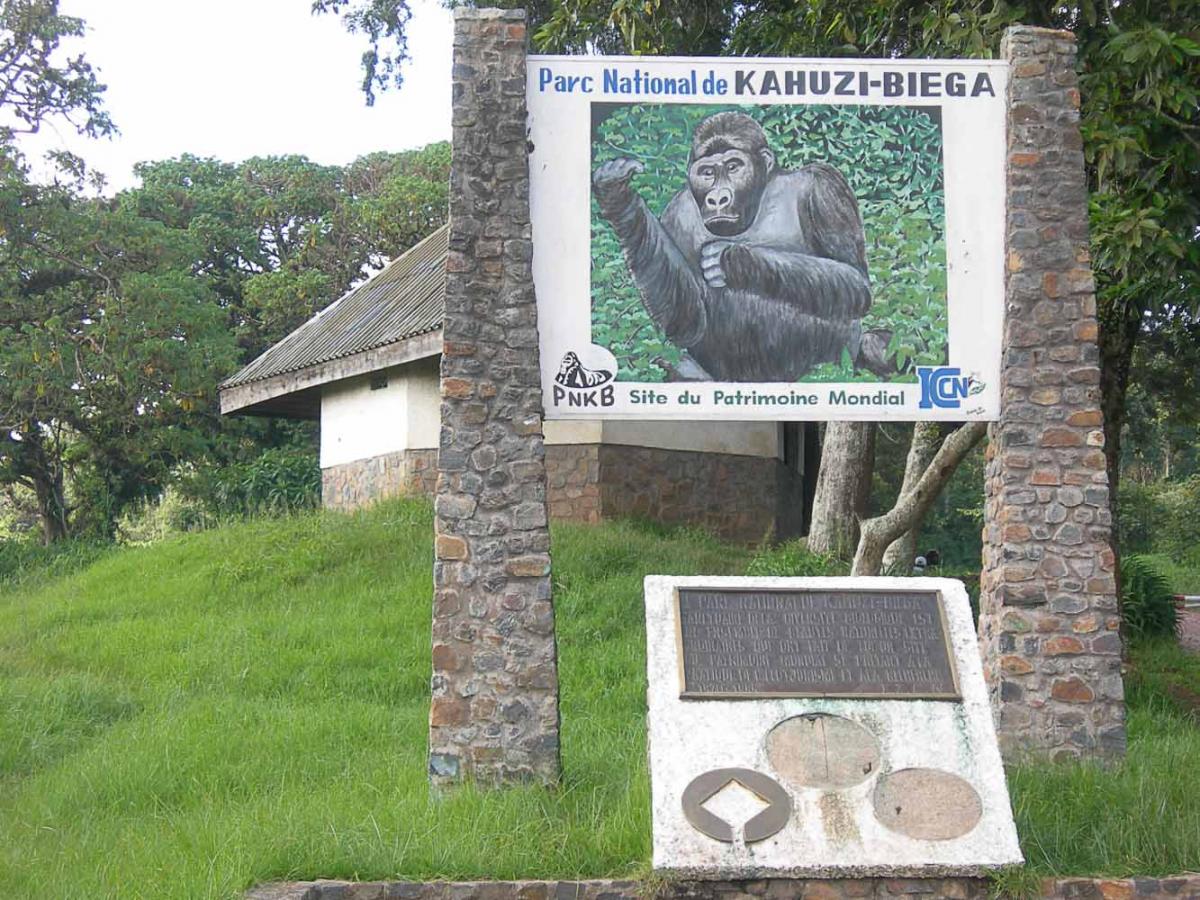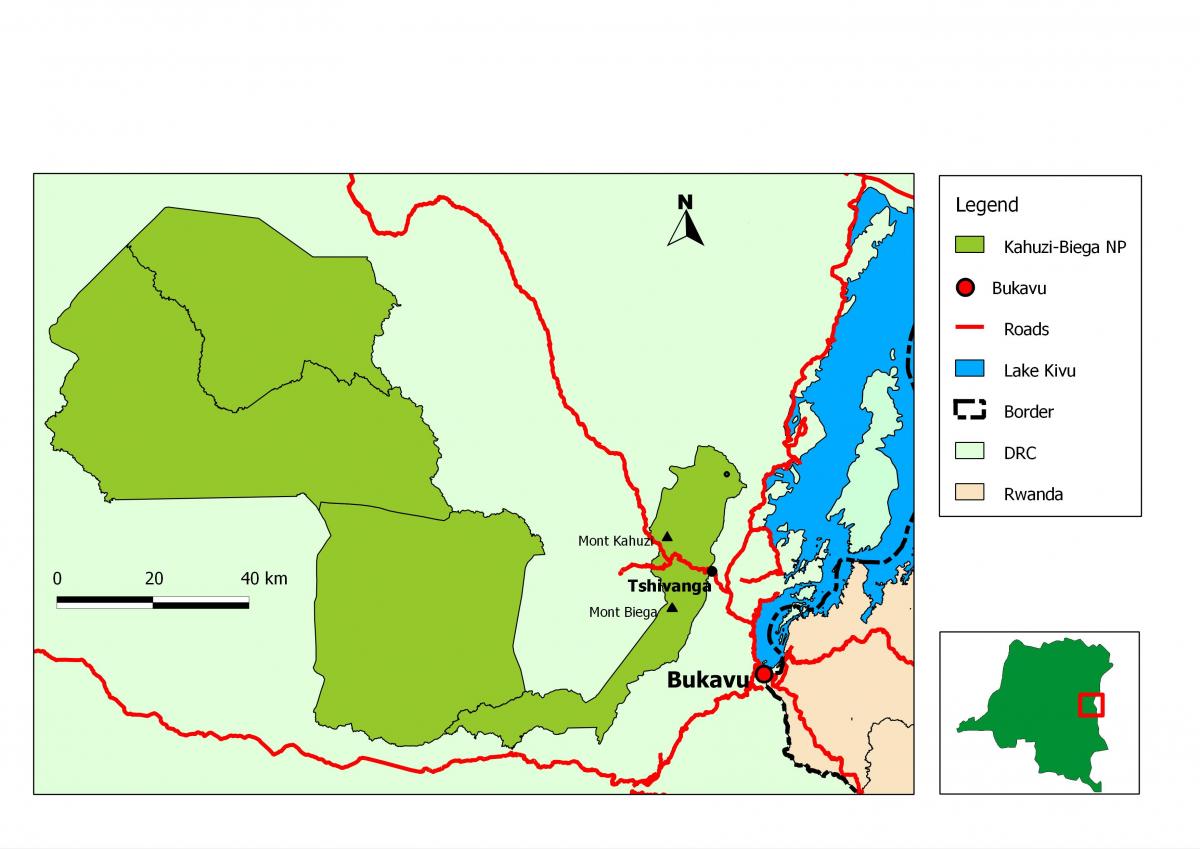 Kahuzi-Biega National Park is in eastern Democratic Republic of the Congo, 50 km west of the town of Bukavu in the Kivu Region, near to the western side of Lake Kivu and the Rwandan border. Kahuzi-Biega National Park (KBNP) was gazetted in 1970 to conserve and preserve the Grauer's gorilla which is the world's largest gorilla species. In 1975 the park was extended from 600 to 6.000 square kilometers to protect the mountain forest and also the virgin forest located at the lower altitudes. Kahuzi Biega is named after two extinct volcanoes, Mount Kahuzi (3,308 m) and Mount Biega (2,790 m). Mount Kahuzi is the highest in this part of Kivu. The park is found in one of the most populated areas of Congo, which put a lot of pressure on the habitat. This park is one of the last refuges of the rare Eastern Lowland Gorilla. Tourism activities started here in 1973 as the first “gorilla trekking” in the world. In 1979 a survey conducted in the mountains of Kahuzi Biega National Park counted 223 gorillas, divided into 14 families and 5 solitary males. Another survey in 1990 counted about 280 gorillas divided into 25 groups and 9 solitary males. In 1990 the park was listed as UNESCO World Heritage Site.
Kahuzi-Biega National Park is in eastern Democratic Republic of the Congo, 50 km west of the town of Bukavu in the Kivu Region, near to the western side of Lake Kivu and the Rwandan border. Kahuzi-Biega National Park (KBNP) was gazetted in 1970 to conserve and preserve the Grauer's gorilla which is the world's largest gorilla species. In 1975 the park was extended from 600 to 6.000 square kilometers to protect the mountain forest and also the virgin forest located at the lower altitudes. Kahuzi Biega is named after two extinct volcanoes, Mount Kahuzi (3,308 m) and Mount Biega (2,790 m). Mount Kahuzi is the highest in this part of Kivu. The park is found in one of the most populated areas of Congo, which put a lot of pressure on the habitat. This park is one of the last refuges of the rare Eastern Lowland Gorilla. Tourism activities started here in 1973 as the first “gorilla trekking” in the world. In 1979 a survey conducted in the mountains of Kahuzi Biega National Park counted 223 gorillas, divided into 14 families and 5 solitary males. Another survey in 1990 counted about 280 gorillas divided into 25 groups and 9 solitary males. In 1990 the park was listed as UNESCO World Heritage Site.

However, the conflicts which have plagued this country since the 1990s have affected the conservation. The 2005 gorilla census in the park suggested that as many as 60% of the population of nearly 300 recorded in Kahuzi-Biega in 1990 may have perished. The fighting in the Congo has moved within the boundaries of the park causing looting, burning of the forest, and poaching of the animals. Because of the wars, the park was added to the list of World Heritage Sites in Danger in 1997. In 1995 there were four gorilla groups open for tourism.
In 2010 gorilla trekking in Kahuzi Biega was open in two gorillas families, Chimanuka (37 members) and Mankoto (19 members). At that time there was an estimate number of 140 gorillas in the park Kahuzi Biega Natio nal Park is divided into two forest zones which are connected by a narrow corridor: on one side of the Park there is mountain forest covering 600 sq km from an altitude of 1,800 m to 3,300 m and on the other side, there is a tropical forest between 600 m and 1,200 m. This makes the Park therefore one of the biggest reserves serving to conserve flora and fauna in central Africa's high mountain regions.
Despite its internationally important biological diversity and ecological significance, few people have little knowledge about the Park. Even Virunga National Park which is its neighbor slightly to the North is much better known. As a result of political and war unrests, the park receives few visitors who mainly visit to see the Grauer's gorilla.
Besides low land gorilla tracking in the Park, the park also offers a lot of other activities since it is a home to 135 other mammal species which include twelve species of primates (amongst them eastern chimpanzees, red colobus, Blue monkey, Red Tailed monkey, L'Hoest monkey, Owl-faced monkey, Angolan black and white colobus, baboons, grey-cheeked mangabey), forest elephants, leopards, civets, gennets, otters and many antelope and duikers. Thirty of the 336 species birds found in the park are endemic to the Albertine Rift, such as the Rockefeller's sunbird, Ruwenzori Turaco, Grauer's broadbill, Grauer's warbler and Shelley's crimsonwing. There are further 69 species of reptiles and 44 species of amphibians.


